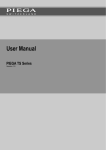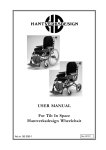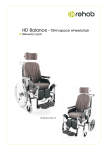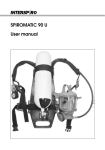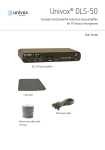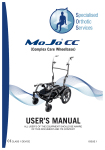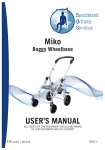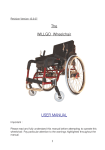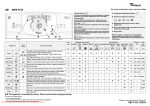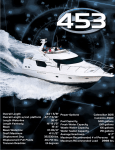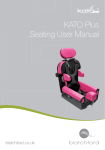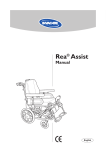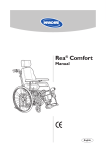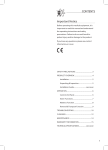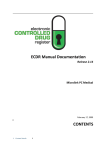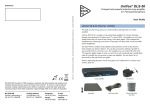Download 95715-1 - HD Rehab
Transcript
HD Balance – Comfort wheelchair Prescriber information | English WE MANUFACTURE QUALITY OF LIFE HD Rehab helps people to improve their quality of life. Our products help to create a comfortable, safe and simple existence for users, relatives and caregivers. HD Rehab offers products designed to assist people with disabilities. Our primary product area is wheelchairs, which we have been designing, developing and manufacturing for over 40 years. We never compromise when it comes to quality. Precision, safety for users and caregivers, functionality and design are vital catchwords for us. We can almost promise that, regardless of which other wheelchair you use, you will notice the difference when you try one of our wheelchairs. FLEXIBLE CREATIVITY IN PRODUCT DEVELOPMENT Whether you are a user, a family member or a caregiver, we want to hear your wishes and points of view. Our designers and developers work closely together on the production of our products in our premises at Lidingö. Our creative employees use their specialist knowledge, experience and imagination to find solutions for each individual’s unique requirements. © 2011 HANTVERKSDESIGN & REHABILITERINGSPRODUKTER AB 2 HD BALANCE | Prescriber information CONTENTS 1. GENERAL 4 1.1 Target group / Areas of use 4 1.2 Testing and adjusting the wheelchair 5 2. CHASSIS 5 2.1 Models 5 2.2 Frame reinforcement 5 2.3 Choice of seat width 5 2.4 Choice of seat depth 5 2.5 Balancing the wheelchair 6 2.6 Seat tilting and backrest reclining 6 2.7 Wheels 7 2.8 Hand rims 7 2.9 Brakes 7 2.10 Push bar 8 2.11 Anti-tip device 8 3. SEAT UNIT 8 3.1 Seat 8 3.2 Backrest 9 3.3 Alternative backrest width 9 3.4 Leg rests 10 3.5 Calf supports and footrests 10 3.6 Armrests 11 4. ACCESSORIES FOR THE HD BALANCE WHEELCHAIR 12 5. TOOLS/ASSEMBLY 14 6. ADDITIONAL INFORMATION 14 6.1 Care and maintenance 14 6.2 Ergonomics & Patient safety 14 6.3 Transportation in vehicles 15 6.4 Permitted changes and combination agreements 15 6.5 Special adaptation 15 6.6 Other documentation 15 7. OVERVIEW OF OPTIONS 16 8. THE PROBLEM SOLVER 18 ADDITIONAL READING: 20 HD BALANCE | Prescriber information 3 1. GENERAL 1.1 Target group / Areas of use This prescriber information is aimed at those who want to have some overall information about HD Balance and the possibilities it provides prior to prescribing the product. This prescriber information is just one part of the documentation that is available regarding HD Balance, and you should also read the User Manual (art. no. 95701), the Info Sheet (art. no. 95930) and the Table of Measurements (art. no. 95719). All documents are based on a HD Balance wheelchair with standard configuration. It is possible to specify an alternative configuration, but you should think carefully before doing so, because this can sometimes entail limitations and certain risks. More information is available in the document entitled Risk Info - Special Adjustments (art. no. 95707). HD Balance is a manual comfort wheelchair intended for use by persons in need of sitting comfort, support and stability that is superior to what active and all-round wheelchairs can provide. The multitude of possible settings gives the user an individually customised sitting position that is well balanced and that provides maximum pressure relief. A complete user manual is always delivered with the wheelchair. Make sure that the user manual is always available when the wheelchair is used. The abbreviated user instructions supplied in the plastic pocket on the back of the wheelchair are only intended as a supplement to the main user manual. Functions such as the tilting seat and reclining backrest provide good possibilities to create variation between a stable and active sitting position and a relaxed resting position. Please be aware that sitting in the same position for a long time without changing position can lead to discomfort and harmful pressure. Symptoms of harmful pressure could be pain and redness of the skin that could eventually give rise to pressure-related sores. HD Balance is intended for use in everyday situations, both indoors and outdoors, and it can be propelled forward by the user himself/herself or the caregiver. The standard design of both the HD Balance 16 and HD Balance 24 models is very well balanced and easy to manoeuvre. A well-placed point of balance and a short wheelbase contribute to these characteristics. If the wheelchair is to be used by several different users, each user’s special requirements must be taken into consideration. Furthermore, the wheelchair’s upholstery on the backrest and seat cushion should be washed or changed before each new user starts using the wheelchair. Washing instructions can be found on the upholstery. The maximum allowable user weight is stated in the Table of Measurements, Document no. 95719. IMAGE 1. Model 24 Io the left and Model 16 to the right. 4 HD BALANCE | Prescriber information 1.2 Testing and adjusting the wheelchair Prescription should always take place before beginning to use a HD Balance wheelchair. This applies to a new wheelchair as well as when an existing wheelchair changes users. Please be aware that a new prescription could be required if a user’s disability changes or new requirements arise. All prescriptions and adjustments of the wheelchair MUST be carried out by authorised personnel. HD Balance should be tested and the settings should be adjusted by trained personnel (Prescribers). An assessment of the user’s safety should be carried out in conjunction with this process. Instructions about how the wheelchair is to be used should have been given to users, family members, assistants or caregivers at the time the wheelchair is put into use. Please feel free to use the user card as part of this process, although it may not replace the carrying out of a personal review. It is recommended to check the wheelchair’s functions on a daily basis; please see the user manual for more information. 2. CHASSIS More information about measurements and dimensions, how to change the settings and how accessories should be assembled is available in the user manual, info sheet and assembly instructions. The latest versions of these documents are available at www. hdrehab.se. 2.1 Models HD Balance comes in two different designs; one with 24” drive wheels and one with 16” drive wheels, please see Image 1. The HD Balance 24 model is for users who can completely or partially drive the wheelchair themselves by using hand rims on the drive wheels. This model also passes somewhat more easily over obstacles such as, for example, curbs. HD Balance 16 is a transportation model for users who do not drive the wheelchair themselves. The 16” wheels enable the caregiver to come closer to the user in different situations. Please see the Chassis Info Sheet for more information. 2.2 Frame reinforcement If the user has a pattern of movement/behaviour that places more strain on the wheelchair than use by a normal user, the user should use a wheelchair in a reinforced design. This applies to users with, for example, a high degree of hypertonia/spasticity. The wheelchair is then reinforced in the wheel frame, seat frame and backrest frame to increase its strength. It is also possible to add a more flexible backrest to the wheelchair. This saves wear and tear on the wheelchair’s components but must be assessed in each individual case. For the user’s safety, more regular and careful maintenance is required when using a wheelchair for which the frame has been reinforced. The life-span of the wheelchair will also be shorter in these cases. 2.3 Choice of seat width There are four seat widths available for HD Balance: 38, 42, 46 and 50 cm. In order to be able to further adjust the seat width to suit the user, extra side paddings are available as accessories which can be attached to the side supports in order to reduce the seat width. Please see the Chassis Info Sheet for more information. 2.4 Choice of seat depth HD Balance is available with a standard or extended seat frame. The wheelchair with the extended seat frame is also equipped with an extended seat plate and an extended seat cushion. Please see the Chassis Info Sheet for more information. HD BALANCE | Prescriber information 5 2.5 Balancing the wheelchair The wheelchair is well-balanced in its standard design and suits most users’ requirements. One should always strive to achieve a satisfactory standard configuration, but in certain special cases the wheelchair’s basic configuration may need to be changed. This should be very carefully considered, and any possible risks should be carefully assessed, in each individual case. MOVING THE DRIVE WHEELS The drive wheels can be assembled in two different positions, front and rear, according to Image 2. As standard the HD Balance is delivered with the drive wheels in the front position. Tests have shown that this provides a wheelchair that is easy to drive and that has sufficiently good stability for normal users. IMAGE 2. The rear wheel has a front and rear position. For maximum stability, the drive wheels can be assembled in the rear position. This provides a more stable wheelchair that is somewhat heavier to drive. If the user often sits with a significantly reclined backrest and seat, the rear wheel position should be used. BALANCING THE SEAT UNIT (SHIFTING THE CENTRE OF GRAVITY) The balance plates that connect the wheel frame and the seat frame can be exchanged for alternative varieties. The seat unit can thus be moved forward or backward. Please see Image 3. IMAGE 3. The positioning of the balance plates. SETTING THE HEIGHT OF THE SEAT UNIT The height of the seat can be adjusted by exchanging the balance plates for a lower or higher variety. It is also possible to lower the height of the seat on the HD Balance 24 by changing to smaller drive wheels and castors. - Always be aware that the risk for tipping could increase when you change the balance and height of the wheelchair! - Document no. 95759 entitled “Reference Table – balance configurations” and Document no. 95758 entitled “Reference Table – balancing modes” set out the different combinations of balancing and seat height raising/lowering that are allowed, along with the limitations that such adjustments may entail. Please read these documents carefully before ordering special design adjustments. 2.6 Seat tilting and backrest reclining The seat unit on the HD Balance wheelchair can be tilted 0 - 20 degrees, please see Image 4a. It is even possible to increase the angle of tilt to a range of -5 - 30 degrees, but this could entail increased risk for tipping. It is also possible to limit the angle of tilt. Please see the Seat Tilt/Backrest Recline Info Sheet for more information. a b IMAGE 4. The seat unit can be tilted from approx. 0 - 20° (a) and the backrest can be reclined from 90 - 120° (b). 6 HD BALANCE | Prescriber information Please note than an individual risk assessment should be carried out by the prescriber in each individual case. The body shape and weight of different users affects the wheelchair’s balance to different extents.RECLINING THE BACKREST The backrest can be continuously reclined from 90 - 120 degrees, please see Image 4b. The angle of the backrest is regulated with the aid of a gas spring that is assembled under the seat of the wheelchair. The gas spring provides a lifting force that helps with the raising of the backrest. The possibility to regulate the angle of the backrest can be taken away and replaced with a fixed angle backrest that can be set to an angle between 90 and 105 degrees. This can be specified when the wheelchair is ordered, or the change can be made by an authorised technician at a later time. CONTROLS The seat tilt control is green and is located on the right-hand side of the push bar, while the backrest recline control is grey and is located on the left-hand side of the push bar. Each of these controls should be adjusted individually, in other words not at the same time. Please only use moderate force when adjusting the controls. 2.7 Wheels HD Balance is available in two models: HD Balance 16, which has 16” rear wheels, and HD Balance 24, which has 24” rear wheels. Both models are equipped with 7” (175 mm) front castors. All tyres on a HD Balance wheelchair, regardless of the model, are solid and puncture proof as standard. As an alternative, it is possible to order pneumatic tyres and tyres with a Flexel tube to make the wheelchair easier to manoeuvre when the user is heavy. The rear wheels are equipped with a quick release function. 2.8 Hand rims The hand rims on a HD Balance wheelchair are made of aluminium as standard. As an alternative, it is possible to order other hand rims that are plastic-coated for better grip, and hand rims in stainless steel that are more durable than the aluminium ones. The hand rims may not be removed, since the wheel construction will then be weakened. The total width of the wheelchair can instead be narrowed by moving the hand rim closer to the wheel and level with the hub (Narrow positioned hand rim). 2.9 Brakes As standard, a HD Balance wheelchair is equipped with push bar side units with a combined main brake and parking brake (the caregiver brake). The HD Balance 24 model is also equipped with separate parking/user brakes. These can also be ordered as an optional extra for the HD Balance 16 model. The combined main brake and parking brake (the caregiver brake) can be deselected from both the HD Balance 16 and HD Balance 24 model. COMBINED MAIN BRAKE AND PARKING BRAKE (THE CAREGIVER BRAKE) The brake levers are located under the push bar/operating handles and are operated by the caregiver from the back of the wheelchair. The parking brake consists of a socket that locks the brake into parked mode. PARKING BRAKE / USER BRAKE On the HD Balance 24 model there is a separate parking brake for the user. This brake is a tyre brake and it is also possible to order this brake for the HD Balance 16 model if you so wish. If the user has difficulty reaching the brake lever, or if he/she is not strong enough to operate the standard lever, it is possible to order longer brake levers for the HD Balance 24 model. HD BALANCE | Prescriber information 7 2.10 Push bar As standard, a HD Balance wheelchair is equipped with a push bar and height-adjustable push bar side units. The side units can be 12 cm higher than the standard push bar, and it is also possible to order separate operating handles [a] when the caregiver who will be pushing the wheelchair is tall. As alternatives it is possible to order separate operating handles, an extra-depth push bar, or a push bar that is both elevated and bent. All the alternatives can be ordered with extended side units/push bar handles. These are used in situations where the caregiver who will be pushing the wheelchair is tall. Furthermore, it is possible to order an adjustable angle push bar that can be set to three different positions (angles). SEPARATE OPERATING HANDLES can be selected if, for example, a stair climber is to be used. THE EXTRA-DEPTH PUSH BAR can be selected if, for example, a power pack is to be used. THE ELEVATED AND BENT PUSH BAR can be selected if the user will mostly be using the wheelchair in the tilted seat and/or reclined backrest mode. THE ADJUSTABLE ANGLE PUSH BAR can be easily regulated based on the user’s sitting position and/or the caregiver’s height. 2.11 Anti-tip device An anti-tip device is part of the standard equipment on all HD Balance models. Please note that the anti-tip device for the 16” model is somewhat different in design from the anti-tip device for the 24” model. Please make sure that you use the right anti-tip device for the right model. The height of the anti-tip device can be set to three different positions (heights) and it can also be turned and locked into inactive mode when, for example, you are passing over a curb or doorstep. You should always have the anti-tip device fully extended in active mode when there is a risk of tipping backwards, and always remember to turn back and lock the anti-tip device into position again if you have had it in inactive mode. You can also place your foot against the anti-tip device to gain a firm footing when, for example, the wheelchair is to be angled up onto its rear wheels. PLEASE NOTE! The risk for tipping can vary depending on the user’s weight, body shape and placement in the chair. Other factors that affect the risk of tipping include the angle at which the seat is tilted, the angle at which the backrest is reclined, the angle of the leg rests, the placement of the rear wheels, and any additional load being placed on the chair’s backrest. The risk for tipping should always be checked in relation to the situation in which the wheelchair is being used at any given point in time, and the anti-tip device settings should be adjusted accordingly. Please be aware that the wheelchair may NOT be used without the anti-tip device! 3. SEAT UNIT More information about measurements and dimensions, how to change the settings and how accessories should be assembled is available in the user manual, info sheet and assembly instructions. The latest versions of these documents are available at www.hdrehab.se. 3.1 Seat A HD Balance wheelchair is equipped with a depth-adjustable seat plate to provide the user with a good support area and maximum pressure distribution. The depth is adjusted via a lever located under the seat plate. The seat plate is equipped with Velcro for attaching the seat cushion. SEAT CUSHION A HD Balance wheelchair is equipped with a cut-to-shape seat cushion made of foam with a comfortable seat indentation, thigh support and pommel. The front edge of the seat cushion 8 HD BALANCE | Prescriber information is angled with an overhang which minimises the risk for pressure on the hollow of the user’s knee. The seat cushion is attached to the seat plate with Velcro. There are three alternatives available when it comes to the seat cushion’s upholstery: grey Trevira (standard), black Trevira or Dartex (disinfectable). Extra seat covers (that can be placed over the existing cover) are available as accessories in black Trevira. These are elastic and can be slipped over the existing seat cover to provide an extra washable layer of protection. The extra seat covers are available both with and without incontinence protection. 3.2 Backrest FLEXI BACKREST SYSTEM As standard, a HD Balance wheelchair is equipped with the Flexi backrest system. The Flexi backrest system consists of the Flexi backrest frame with seven adjustable straps as well as the Flexi backrest cushion. The straps can be adjusted to provide the user with good pelvic and lumbar support. It is also possible to create extra space for the user’s backside or hunched back by loosening the straps. Good side support for users who lean to the side can be achieved by loosening all the straps and scooping the backrest cushion. The Flexi backrest system is also available in an extended version for tall users. Please see the user instructions for information about how to adjust the Flexi backrest system. If additional support for the trunk is required, it is possible to order a thoracic support. Please see the Accessories section for more details. FLAT BACKREST As an alternative to the Flexi backrest system, it is possible to order a flat backrest consisting of a solid backrest plate in aluminium. The flat backrest is also available in an extended version for tall users. ADJUSTING THE HEIGHT OF THE BACKREST There are two ways to adjust the height of the backrest. One way is via the tracks in the Flexi frame for stepless height adjustment. If further height adjustments are required, the backrest brackets can also be moved somewhat along the backrest frame’s side tubes. BACKREST CUSHION The Flexi backrest cushion is made of foam with cut-to-shape side wings in order to provide soft but stable side support. As an alternative, it is also possible to order a flat backrest cushion made of foam that does not have wings. The same backrest cushions that are used with the Flexi backrest system are also used with the flat backrest. There are three alternatives available when it comes to the backrest cushion’s upholstery: grey Trevira (standard), black Trevira or Dartex (disinfectable). 3.3 Alternative backrest width A HD Balance wheelchair can be equipped with a wider backrest to provide better support for users with broad shoulders and narrow hips. It is also possible to equip the wheelchair with a narrower backrest for users who have a narrow upper body but are wider around the hips and backside. HD BALANCE | Prescriber information 9 3.4 Leg rests There are two varieties of leg rest available: fixed angle leg rests and adjustable angle leg rests. As an alternative it is also possible to order amputee leg rests. The HD Balance wheel frame is designed in such a way that all types of leg rest can be used at 90 degrees with the standard configuration of the wheelchair, without causing any disturbance to the castors. The 90 degree position is useful, for example, when the user has knee contractures, or in order to break up the stretch spasticity in the legs. Leg rests are available in three different lengths: standard, short and long. Please see the Leg Rests Info Sheet (Art. no. 95933) for more information. ADJUSTABLE ANGLE LEG RESTS Adjustable angle leg rests consist of an upper leg rest, a calf support and a footrest. They can be assembled and removed in a simple fashion involving the use of only one hand, without the user’s lower legs needing to be stretched or straightened out. The leg rests are adjustable from 90 – 180 degrees. The placement of the upper leg rest’s centre of rotation means that the length of the leg rest does not need to be adjusted for most users when the angle of the knee joint is altered (length-compensating). FIXED ANGLE LEG RESTS Fixed angle leg rests are available as an alternative to the adjustable angle leg rests and consist of an upper leg rest, a calf support and a footrest. As with the adjustable angle leg rests, the fixed angle leg rests can be assembled and removed in a simple fashion involving the use of only one hand, without the user’s lower legs needing to be stretched or straightened out. The fixed angle leg rests are available in a 90° and 105° design as standard, although they can also be specially made at an angle of your choice. AMPUTEE LEG RESTS Adjustable angle amputee leg rests are available as accessories and can be adjusted at an angle from 140 – 180 degrees. Amputee leg rests are removable and can be turned out sideways. The height and depth of the amputee leg rest’s padded calf plate is adjustable. 3.5 Calf supports and footrests CALF SUPPORTS A HD Balance wheelchair features separate calf supports as standard. As an alternative, it is possible to order a one-piece calf support, calf panel and calf strap. The height, depth and angle of the separate calf supports and the one-piece calf plate are adjustable. FOOTRESTS A HD Balance wheelchair features separate footrests as standard. The height, depth and angle of these separate footrests are adjustable. As an alternative, it is possible to order a one-piece footrest or foot box. Both of these are height-adjustable, and the angle of the onepiece footrest can also be adjusted. All footrests can be used with both the adjustable angle leg rests and the fixed angle leg rests. A shorter variety of footrest is available for users with short legs. Heel straps and pads for the footrests can be ordered as accessories. You can find more information about how to combine long and short footrests with different lengths of leg rest in the Leg Rests Info Sheet (art. no. 95933). 10 HD BALANCE | Prescriber information 3.6 Armrests There are three varieties of armrest available: the standard armrest, the low armrest and the hemiplegia armrest. STANDARD ARMRESTS The standard armrest consists of a height- and depth-adjustable padded armrest plate and a padded side support. The height and depth of the armrest plate can be adjusted without the use of tools. When it comes to the height setting there is a graduated scale so that the armrests can easily be set to the same height. The depth of the armrest plate can be regulated to provide support for the user’s elbows in different sitting positions. For example, the armrest plates can be pushed forward to provide support when getting up from the chair, and they can be pushed back when the user needs to get close to a table. LOW ARMRESTS The low armrest consists of a height- and depth-adjustable padded armrest plate and a side support in plexiglass. Pads for the side supports are available as accessories. The height and depth of the low armrest is adjusted in the same manner as for the standard armrest. The low armrest is used for short users or users with a hunched sitting position. HEMIPLEGIA ARMRESTS Hemiplegia armrests are available in both a right-handed and left-handed version and consist of a padded upper armrest and a padded side support. The upper armrest is shaped to provide support to the user’s arms and can be adjusted in terms of height, depth and width. It can also be rotated in front of the body. The hemiplegia armrests are, for example, used for users who lean to one side, who have pain in their arm/shoulder, or who have their arm in a cast. WEDGE-SHAPED SIDE SUPPORTS As an alternative, the standard armrests can be equipped with wedge-shaped padded side supports. In the case of external rotation of the hips, these side supports straighten up the user’s thighs to a parallel position. The pressure is distributed along the thighs, and the pressure point at the knee joints is reduced. The wedge-shaped side supports are somewhat longer than the standard side supports. HD BALANCE | Prescriber information 11 4. ACCESSORIES FOR THE HD BALANCE WHEELCHAIR Below is a list of the accessories that are available for the HD Balance wheelchair. Please read the latest version of the relevant info sheet carefully before selecting and using an accessory. The latest versions of the info sheets are available at our website, www.hdrehab. se. An assessment must always be carried out as to whether an accessory might entail increased risks for the user before a decision about the use of the accessory is taken. For example, it could be a matter of the risk of the user getting squashed, of him/her getting stuck between the accessory and the wheelchair, or of an increased risk of the wheelchair tipping over. The assessment of potential risks is particularly important when it comes to users with special patterns of movement, such as in the case of users with spasticity, exaggerated movements, etc. HEADRESTS AND NECK RESTS Two alternative means of supporting the user’s head/neck are available: a headrest and a neck rest. The headrest provides somewhat enhanced and scooped support for the head. The neck rest is a bit smaller and softer and provides support for the back of the neck. The headrest and neck rest are also available with a sideways-adjustable head support cushion and with brackets for side support. Side support can be used on one or both sides and is available in both a fixed angle and an adjustable angle design. THORACIC SUPPORT There are two varieties of thoracic support available: standard and adjustable. These are used to provide the user with a more stable sitting position and to prevent the user from leaning to the side or at a forward angle. The thoracic support is available with different mounts and in different sizes to suit users of varying size. All types of thoracic support have the swing-away function, which allows one to swing away the thoracic support cushion, for example in a patient transfer situation. The mounts for the thoracic support are ordered separately or together with the thoracic support. POMMELS There are two varieties of pommel available, standard and forward mounted, and they are available in two sizes, large and small. They are used to provide support to or separate the user’s legs, and are height-adjustable. The standard variety is also depth-adjustable. The pommel mount is assembled onto the seat plate. TABLE TRAYS The table trays are available in wood (oak) and PC (polycarbonate), with space for the trunk. Both varieties of table tray can be ordered with pads for the elbows. The table trays have a small border that prevents objects from falling off. The table tray brackets are available in two versions: standard (not lockable) and lockable. POSITIONING BELTS There are two varieties of positioning belt available: a 2-point belt with two attachment points, and a 4-point belt with four attachment points. The length of the belt is adjustable, with tightening straps set two positions from the middle. The belt mounts are ordered separately and are used to mount the belt onto the wheelchair’s seat frame in the desired position. SPOKE PROTECTION Spoke protection can be assembled on 20” and 24” drive wheels. The spokes are hidden behind a transparent plastic disc that eliminates the risk of injuries to hands and fingers. EXTRA SIDE PADDINGS The extra side paddings enable you to adjust the width of the seat according to the user 12 HD BALANCE | Prescriber information and provide extra stability for the hips and thighs. They are attached to the inside of the armrest’s side support with the help of a pocket at the front and Velcro at the back. BAG HOOK The bag hook is assembled onto the push bar and is intended for use with lighter types of bags and other such items. Please remember that the risk for tipping increases if more weight is applied to the wheelchair and/or if the wheelchair’s seat and/or backrest are angled backwards. IV POLE The IV pole is used to give the user the possibility to sit up in the wheelchair even when an IV drip or tube feeding is being administered. When the seat is tilted and/or the backrest is reclined, the angle of the mount is adjusted so that the IV pole can be kept vertical. The IV pole is removable. The IV pole entails an increased risk of tipping, especially in case of heavy drip bags and when the seat is tilted. COAMING FOR ARMREST The coaming for the armrest is assembled onto the armrest rail and prevents the user’s arm from sliding off the armrest pad backwards or to the side. This can be useful in a reclined sitting position or if the user’s arm is weak after a stroke. CHEST HARNESS BRACKET The chest harness bracket is intended to provide attachment points for various chest harnesses and similar products. The chest harness bracket is assembled onto the wheelchair’s Flexi backrest system, and both sides of the chest harness bracket are individually adjustable in terms of height, width and angle. ADDITIONAL COVER FOR SEAT CUSHION The additional cover is pulled over the wheelchair’s existing upholstered seat cover and facilitates the washing and quick changing of the seat cover. The additional cover’s upholstery, in black Trevira, is available in a standard and an incontinence variety. HEEL STRAPS The heel straps prevent the user’s feet from sliding backwards off the footrests. They are assembled via the two rear holes on the footrests. PADDING FOR FOOTRESTS The padding for the footrests is pulled over the footrests to provide a soft base for the user’s feet if he/she is sitting in the wheelchair without shoes. SIDE SUPPORT PADDING FOR LOW ARMREST The side support padding is attached to the side support’s plexiglass plate with the help of two pockets and is available as an accessory for the low armrest. PROFILE STOP The profile stop is a clamp that is attached around the headrest’s/neck rest’s bracket or the thoracic support’s bracket. It is used as a “reminder” to facilitate the placement of the headrest/neck rest or thoracic support in exactly the same position as the prescriber has set. HD BALANCE | Prescriber information 13 5. TOOLS/ASSEMBLY The most common settings on a HD Balance wheelchair can be achieved with the aid of the following tools: (Under the cross beam of the seat there is a 10 & 13 mm wrench attached with Velcro) Please note that certain settings require the assistance of authorised technicians! 10 MM WRENCH - Assembling the Flexi backrest system - Adjusting the height of the Flexi backrest - Adjusting the depth of the calf plates - Adjusting the angle of the foot plates - Assembling and adjusting the height of the thoracic support mount PHILLIPS SCREWDRIVER 3 MM ALLEN KEY 4 MM ALLEN KEY - Adjusting the seat tilt (inertia) - Assembling the belt mount - Assembling the pommel mount - Assembling/adjusting the profile stop - Assembling the push bar/separate operating handles - Adjusting the depth of the separate footrests - Adjusting the Thoracic Support Swing 6. ADDITIONAL INFORMATION 6.1 Care and maintenance In order to achieve the best safety and a long product life, the wheelchair should be kept clean and in good condition. Please see the maintenance instructions (art. no. 95730) for more information. All upholstery for the wheelchair’s cushions and accessories is washable at 60 degrees (washing instructions can be found on the inside of the upholstery). Any errors and faults that arise should be rectified immediately. How the wheelchair is used affects the need for maintenance. In situations of strenuous use in the case of, for example, users with a high degree of hypertonia and special patterns of movement, or when the wheelchair is used outside a lot, more regular maintenance of the wheelchair is required. The estimated life of the product when used normally by one and the same user is ten years. This assumes that the wheelchair is cared for and maintained in accordance with the instructions provided in the user manual and the maintenance instructions. When using a power pack, in the case of frame reinforcements and other special design adaptations to the wheelchair, and in the case of extreme use, the estimated life of the product is reduced to 5 years. In such cases the care and maintenance should be carried out at more regular intervals. 6.2 Ergonomics & Patient safety A HD Balance wheelchair is equipped with scales that indicate the current angle/tilt of the seat and the backrest, the angle of the knee joint and the height of the armrests and the depth of the seat. In relation to these scales there is a user card in which the prescriber can enter the recommended settings for each individual user. This is a good way to simplify the communication between prescribers and caregivers/relatives/users. These scales improve the safety of the patient by reducing the risk for the patient sitting in an incorrect position. User cards can be ordered separately if they need to be replaced. A HD Balance wheelchair is ergonomic for caregivers. The wheelchair’s short wheelbase contributes to good characteristics when it comes to driving and manoeuvring the wheelchair. Thanks to well-designed balancing it requires very little effort to tilt the seat unit. The seat tilt and backrest recline controls are positioned so that they are easy to reach, and 14 HD BALANCE | Prescriber information one can maintain one’s hold on the push bar while adjusting these controls. The positioning of the controls also contributes to a more symmetrical working position for the caregiver. 6.3 Transportation in vehicles A HD Balance wheelchair is tested and approved, in accordance with ISO 7176-19:2008, for the transportation of users in vehicles while they are strapped in to the wheelchair. A headrest/neck rest should be used when travelling in a vehicle. The instructions provided in the user manual should always be followed carefully. On the wheelchair’s rear wheel frame there are transportation brackets, and the front attachment points are marked on the front part of the wheel frame. A HD Balance wheelchair can easily be collapsed for transportation without a user. Please see the Table of Measurements, Document no. 95719, for the relevant measurements and dimensions in relation to transportation situations. 6.4 Permitted changes and combination agreements The use of other suppliers’ products together with a HD Balance wheelchair is regulated by way of combination agreements. Our instructions and recommendations must be followed in order for the CE marking to be valid. The document entitled “Permitted changes with the CE marking intact” (art. no. 95724) specifies which changes are permitted to be made to a HD Balance wheelchair while still retaining the validity of the CE marking, as well as information about which combination agreements that exist. The document is available at our website, hdrehab.se, and is updated on an on-going basis. 6.5 Special adaptation If a user requires further special adjustments to his/her wheelchair, in addition to the alternatives provided for in the standard HD Balance product range, HD Rehab can make specially customised products. You will find more information about this in the document entitled “Information about specially customised products” (art. no. 95431). 6.6 Other documentation The following documentation (among others) is available related to the HD Balance wheelchair: 95701 USER MANUAL 95707 RISK INFORMATION – CONFIGURATIONS AND ACCESSORIES 95710 ABBREVIATED USER INSTRUCTIONS 95717 OVERVIEW OF OPTIONS 95718 OVERVIEW OF ACCESSORIES 95719 TABLE OF MEASUREMENTS 95720 TECHNICAL INFORMATION 95724 PERMITTED CHANGES 95725 RECONDITIONING INSTRUCTIONS 95730 MAINTENANCE INSTRUCTIONS 95758 REFERENCE TABLE – BALANCING MODES 95759 REFERENCE TABLE – BALANCE CONFIGURATIONS 95801 - 95850 ASSEMBLY INSTRUCTIONS 95930 - 95950 INFO SHEETS The latest versions of these documents are always available at our website, www.hdrehab.se, along with other useful documentation. HD BALANCE | Prescriber information 15 7. OVERVIEW OF OPTIONS Tables 1, 2 and 3 below provide an overview of the options and settings available for HD Balance. Please note that some of these alternatives could affect the wheelchair’s set-up possibilities or restrict its use. Please refer to the relevant Info Sheet for each section before making your decision regarding the configuration of the wheelchair. TABLE 1. OPTIONS TO BE DECIDED ON AT THE TIME OF ORDERING THE WHEELCHAIR AND THAT CAN’T BE ALTERED AT A LATER STAGE MODEL 16 24 SEAT WIDTH 38 42 LENGTH SEAT FRAME STANDARD. (45-55 CM) EXTENDED (50-60 CM) FRAME REINFORCEMENT STANDARD REINFORCED SEAT, BACKREST- AND WHEEL FRAME 46 50 CHOCK ABSORBING BACK TABLE 2. OPTIONS THAT CAN BE DECICED ON AT THE TIME OF ORDERING THE WHEELCHAIR OR THAT CAN BE REPLACED/CHANGED BY AUTHORISED TECHNICAL PERSONNEL BALANCING OF SEAT UNIT STD PLACEMENT FORWARD 3 CM POSITION OF WHEEL STD PLACEMENT BACKWARD POS. ( 5 CM) SEAT HEIGHT STD PLACEMENT INCREASED (5 CM) DECREASED (3 CM) 0 - 30 ° BACKWARD 3 CM SEAT TILT STD 0 - 20 ° -5 - 20 ° BACKREST ANGLE STD 0 - 30 ° FIXED (90-105 °) SIDE UNIT STANDARD INCREASED HEIGHT BRAKE CAREGIVER BRAKE USER BRAKE (STD ON BALANCE 24) PUSH BAR STD PUSH BAR EXTENDED DEPTH PUSH BAR EXTENDED & BENDED STANDARD EXTENDED WITHOUT FLEXI FLEXI EXTENDED FLAT FLAT EXTENDED BACKREST WIDTH SAME AS SEAT WIDTH WIDE + 4 CM WIDE + 8 CM NARROW - 4 CM BACKREST CUSHION STD WITH SIDE SUPP. STD WITHOUT SIDE SUPP. EXTENDED WITH SIDE SUPP. EXTENDED WITHOUT SIDE SUPP. WITHOUT ADJUSTABLE ANGLE AMPUTEE FIXED ANGLE 90° FIXED ANGLE 105 ° WITHOUT LEGREST LENGTH STANDARD SHORT LONG CALF SUPPORT SEPARATE ONE PIECE CALF PANEL CALF STRAP WITHOUT FOOTREST SEPARATE ONE PIECE FOOTBOX WITHOUT FOOTREST LENGTH STANDARD SHORT ARMREST STANDARD LOW HEIGHT HEMIPLEGIA WITHOUT POLYURETHAN STANDARD POLYURETHAN SLIM (ENDAST 24”) PNEUMATIC FLEXEL HAND RIMS ALUMINIUM STAINLESS STEEL SOFT GRIP POSITION OF HAND RIMS STANDARD NARROW PUSH BAR/HANDLES SEAT CUSHION BACKREST SYSTEM LEGRESTS TYRE ADJUSTABLE ANGLE 16 -5 - 30 ° HD BALANCE | Prescriber information SEPARATE OPERATING HANDLES WITHOUT TABLE 3. SETTINGS THAT CAN BE DETERMINED / ARE DETERMINED BY THE PRESCRIBER DURING THE TESTING OF THE WHEELCHAIR SEAT TILT SEAT ACTIVATION OF FORWARD TILT -5 ° DEPTH, 7 POS. BACKREST HEIGHT, BACKREST SYSTEM BACKREST SHAPE, 7-8 STRAPS INDIVIDUALLY ADJUSTABLE FOR EACH USER BRAKE, TILT LOCK INDIVIDUALLY ADJUSTABLE DEPENDING ON USER WEIGHT HEIGTH, BRACKET FOR BACKREST SYSTEM ARMREST STD HEIGHT DEPTH ARMREST HEMIPLEGIA HEIGHT DEPTH WIDTH LEGREST ADJUSTABLE ANGLE ANGLE CALF SUPPORT HEIGHT DEPTH ANGLE FOOTREST HEIGHT DEPTH ANGLE PUSH BAR HEIGHT ANGLE (ONLY THE ANGLE ADJUSTABLE MODEL) ROTATION PLEASE SEE THE RELEVANT INFO SHEET ABOUT EACH ACCESSORY FOR MORE INFORMATION ABOUT THE DIFFERENT SETTINGS AVAILABLE FOR THE ACCESSORIES. HD BALANCE | Prescriber information 17 8. THE PROBLEM SOLVER The problem solver can be used to assist prescribers to provide the user with the best possible sitting position or to satisfy the requirements that exist. It can also be used to help solve problems that may arise on account of the user’s patterns of movement or the nature of the surroundings. The problem solver only provides suggested solutions. It is always the responsibility of the prescriber to carry out an assessment of the user’s situation and to decide which measures are appropriate in each individual case. The table is divided into four sections: THE USER’S BODY PROBLEMS THAT CAN ARISE REQUIREMENTS / USE OF THE WHEELCHAIR THE CAREGIVER’S REQUIREMENTS 18 THE USER IS TALL • • • • THE USER IS SHORT • SHORT FOOTREST LENGTH • REDUCED SEAT DEPTH (BACK DISTANCES) • LOWERED SEAT HEIGHT (E.G. UPRIGHT TRANSFER) THE USER HAS NARROW HIPS AND BROAD SHOULDERS • WIDE BACKREST SYSTEM, +4 OR +8 CM THE USER HAS BROAD HIPS AND NARROW SHOULDERS • NARROW BACKREST SYSTEM, -4 CM THE USER’S CENTRE OF GRAVITY IS LOCATED A LONG WAY FORWARD, E.G. ABDOMINAL OBESITY • BACK MOUNTED SEAT UNIT THE USER’S CENTRE OF GRAVITY IS LOCATED A LONG WAY BACK, E.G. AMPUTATION • REAR POSITIONED DRIVE WHEELS • FORWARD MOUNTED SEAT UNIT • LIMIT THE ANGLE OF SEAT TILT THE USER HAS A LARGE BACKSIDE • SELECT THE FLEXI BACKREST SYSTEM INSTEAD OF A FLAT BACKREST • LOOSEN THE FLEXI BACKREST STRAPS TO MAKE SPACE FOR THE USER’S BACKSIDE THE USER HAS AN ENLARGED THORACIC CAVITY • LOOSEN THE FLEXI BACKREST STRAPS TO MAKE SPACE FOR THE USER’S THORACIC CAVITY • POSSIBLY USE A SOMEWHAT OPEN BACKREST ANGLE TO ELEVATE THE USER’S LINE OF VISION THE USER SLIDES FORWARD ON THE SEAT • CORRECT SEAT DEPTH, BACKREST HEIGHT, ARMREST HEIGHT AND LEGREST POSITION • CORRECT SEAT TILT AND BACKREST ANGLE • POSSIBLY REDUCE THE ANGLE OF THE LEGRESTS • POSSIBLY TILT THE USER’S PELVIS FORWARD WITH THE HELP OF THE FLEXI BACKREST STRAPS • 2-POINT OR 4-POINT POSITIONING BELT EXTENDED SEAT DEPTH EXTENDED HEIGHT, BACKREST SYSTEM LONG LEGREST LENGTH INCREASED SEAT HEIGHT HD BALANCE | Prescriber information THE USER LEANS TO THE SIDE • SELECT THE FLEXI BACKREST SYSTEM INSTEAD OF A FLAT BACKREST • FLEXI BACKREST CUSHION WITH SIDE SUPPORT WINGS • THORACIC SUPPORT, STANDARD OR ADJUSTABLE • HEMIPLEGIA ARMREST • 2-POINT OR 4-POINT POSITIONING BELT • TABLE TRAY • COAMING FOR ARMREST THE USER’S ARM/ARMS FALL(S) OUTSIDE • COAMING(S) FOR ARMREST(S) THE ARMRESTS THE USER’S HEAD HANGS FORWARD • SELECT THE FLEXI BACKREST SYSTEM INSTEAD OF A FLAT BACKREST • CHOOSE SUITABLE FLEXI BACKREST SETTINGS DEPENDING ON THE REASON(S) • CHEST HARNESS + POSITIONING BELT • EXTENDED HEADREST TUBE THE USER PRESSES HIS/HER KNEE(S) AGAINST THE LEGREST’S KNEE JOINT • WEDGE-SHAPED SIDE SUPPORTS THE USER’S LEGS GET STUCK/END UP BETWEEN THE CALF SUPPORTS • • • • THE USER’S LEGS GET STUCK/END UP BETWEEN THE FOOTRESTS • ONE-PIECE FOOTREST • FOOT BOX THE USER KICKS HIS/HER WAY FORWARD • LOWER THE SEAT UNIT • POSSIBLY A SOMEWHAT SHORTER SEAT DEPTH THE USER MAKES UPRIGHT TRANSFERS • UNLOCK FORWARD SEAT TILT (-5°) • RIGHT HEIGHT FOR THE SEAT UNIT THE USER REQUIRES A MORE RECLINED POSITION IN THE WHEELCHAIR • EXTENDED SEAT TILT 30° THE USER CANNOT OR MAY NOT CHANGE THE POSITION OF HIS/HER HIPS • FIXED ANGLE BACKREST • DEACTIVATE THE BACKREST RECLINE CONTROL THE USER REQUIRES GENTLE ADJUSTMENT OF THE BACKREST • SELECT A FLAT BACKREST ON WHICH TO BUILD THE GENTLE ADJUSTMENT (SPECIAL ADAPTATION) THE WHEELCHAIR IS TOO WIDE FOR E.G. DOOR OPENINGS • NARROW POSITIONED HAND RIMS ONE-PIECE CALF SUPPORT FOOT BOX CALF PANEL CALF STRAP • SIDE UNIT, EXTENDED HEIGHT THE PUSH BAR IS TOO LOW FOR THE CAREGIVER, EVEN WHEN IT IS SET TO THE • ADJUSTABLE ANGLE PUSH BAR HIGHEST POSSIBLE POSITION THE PUSH BAR IS TOO LOW BECAUSE THE WHEELCHAIR IS OPERATED IN A RECLINED POSITION • PUSH BAR, EXTENDED & BENDED • ADJUSTABLE ANGLE PUSH BAR THE CAREGIVER BANGS HIS/HER TOES ON THE POWER PACK THAT HAS BEEN ASSEMBLED UNDER THE WHEELCHAIR • PUSH BAR, EXTENDED DEPTH THE WHEELCHAIR’S PUSH BAR PREVENTS THE USE OF A STAIR CLIMBER • SEPARATE OPERATING HANDLES HD BALANCE | Prescriber information 19 ADDITIONAL READING: User Manual - HD Balance, 95701-1 Measures, 95719-1 Info Sheet, 95930-1 - FOLDER | Individual customisation FOLDER | Accessories FOLDER | HD Balance - Interested in our products? HD Balance can be adapted to individual needs and preferences to a large extent. This folder present most of the adaptations contained in the “standard range”. If you need other solutions we can produce special adaptations according to your preferences. Read more about this on our website. Please contact us for more information! HD REHAB The family driven company Hantverksdesign/HD Rehab has developed, manufactured and marketed comfort wheelchairs and accessories for more than 40 years. Our products help make the lives of users, their families and carers easier, safer, and more comfortable. All product development, design and manufacturing takes place at our base in Lidingö, Sweden. Keeping close to our customers and users makes it easy for us to quickly and efficiently convert ideas into new products. Our creative employees use their specialist knowledge, experience and inventiveness to find solutions for each individual person’s unique needs. WWW.HDREHAB.SE [email protected] +46 (0)8 - 767 04 80 SALES & EXPORT MANAGER: Fredrik Melander [email protected] Iadaptation d al n v u i id HD Balance can be adapted to individual needs and preferences to a large extent. This folder present most of the adaptations contained in the “standard range”. If you need other solutions we can produce special adaptations according to your preferences. Read more about this on our website. HD REHAB The family driven company Hantverksdesign/HD Rehab has developed, manufactured and marketed comfort wheelchairs and accessories for more than 40 years. Our products help make the lives of users, their families and carers easier, safer, and more comfortable. All product development, design and manufacturing takes place at our base in Lidingö, Sweden. Keeping close to our customers and users makes it easy for us to quickly and efficiently convert ideas into new products. Our creative employees use their specialist knowledge, experience and inventiveness to find solutions for each individual person’s unique needs. Configuration options for HD Balance - Interested in our products? Please contact us for more information! WWW.HDREHAB.SE [email protected] +46 (0)8 - 767 04 80 SALES & EXPORT MANAGER: Fredrik Melander HD BALANCE HD Balance is a Swedish comfort wheelchair with an innovative design where both carers’ and patients’ needs and demands are in focus. Precision and durability are properties inherited from it’s predecessor, HD 500/600/650. Only material and components of highest quality are used in the manufacturing. Accessories for HD Balance HD REHAB The family driven company Hantverksdesign/HD Rehab has developed, manufactured and marketed comfort wheelchairs and accessories for more than 40 years. Our products help make the lives of users, their families and carers easier, safer, and more comfortable. All product development, design and manufacturing Overview of the takes place at our base in Lidingö, Sweden. Keeping close to our customers and users makes it easy accessories available for us to to quickly and efficiently convert ideas into new Our creative employees use their specialist HD Balance products. knowledge, experience and inventiveness to find solutions for each individual person’s unique needs. [email protected] - The new generation comfort wheelchairs WWW.HDREHAB.SE [email protected] +46 (0)8 - 767 04 80 SALES & EXPORT MANAGER: Fredrik Melander [email protected] - HD Rehab helps people achieve an improved quality of life! - HD Rehab helps people achieve an improved quality of life! - HD Rehab helps people achieve an improved quality of life! Prescription Form, 95750-1 DOCUMENT INFORMATION: ART. NO. : 95715-1 VERSION: B 20 - Interested in our products? Please contact us for more information! PUBLICATION DATE: 2012-08-08 HD BALANCE | Prescriber information




















